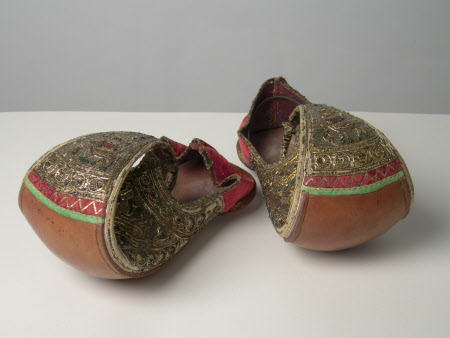Shoe
Category
Costume
Date
1770 - 1800
Materials
Canvas, Coloured glass, Leather, Metal, Silk, Velvet, Silver-gilt, Silver wire, Salma sitari
Measurements
120 mm (H); 245 mm (W); 125 mm (D)
Place of origin
India
Order this imageCollection
Powis Castle and Garden, Powys
NT 1180732.1
Summary
A pair of leather shoes patterned with zardosi embroidered silver-gilt on velvet, unknown maker, South Asia, 18th century. Associated with Tipu Sultan (1750-99), ruler of Mysuru (1782-99).
Full description
The leather soles are in one piece without separate heels, and the uppers are canvas with red velvet. Broadening towards the toes, they taper off and are terminated by a long, pointed strip of leather lined with cloth that curls inwards over the toes. The fronts are richly decorated with zardosi embroidery in silver and silver-gilt wire, thickly encrusted with spangles (salma sitara) and coloured glass beads. The pattern is of blackbuck and flowering plants, bordered with repeating crescent motif. The plain velvet backs are made to flatten down under the heel. Henrietta Clive (1758–1830), later Countess of Powis, may have purchased or been given these shoes while in India with her husband Edward during his tenure as Governor of Madras. A handwritten note in one of the pair in her handwriting reads ‘Tipoo’s Slippers’. In 1804, "1 Pr. Indian Slippers - Prohibited" were recorded in an Inventory of “Sundry things Charged with duty belonging to the Right Honble Lord Clive off Castle Eden”.[NLW Clive Papers, Series 2, 2449] The seizing of cargo was common practice, so that a market value for each item could be established and customs duty charged accordingly. These slippers could have been part of a larger group of clothing and textiles seized by the British army during the plunder of Srirangapatna (formerly called Seringapatam), described in a letter written 19 August 1799 by Arthur Wellesley to Richard Wellesley: "The prize agents have got a large quantity of clothes belonging to, and worn by, the late Sultaun […]I [..] recommend that the whole may be bought by the Government, and either given to the Princes, or anything done with them that you may think fit." [Wellesley, p. 290] Research Note on Provenance: Tipu Sultan succeeded his father as ruler of the South Indian state of Mysuru in 1782, where he built a sophisticated court around his palace at Srirangapatna. Tipu Sultan spent much of his reign engaged in the defence of Mysuru against encroachment by the British East India Company. In 1798, a renewed British campaign provoked the Fourth Anglo-Mysore War. On 4th May 1799, during the Siege of Srirangapatna, Tipu was killed. In the immediate aftermath, the British army looted Srirangapatna. According to Colonel Arthur Wellesley, later the Duke of Wellington, ‘Scarcely a house in the town was left unplundered, and I understand that in camp jewels of the greatest value, bars of gold etc etc have been offered for sale in the bazaars of the army by our soldiers, sepoys and followers. I came in to take command of the army on the morning of the 5th and with the greatest exertion, by hanging, flogging etc etc in the course of that day I restored order…’ [Dalrymple, p. 359] The resumption of control by the higher ranks of the army enabled the work of the prize committee to begin. Prize committees were responsible for ‘collecting, inventorying and disposing of booty seized from the enemy and for compiling detailed lists of who had served under whom in each campaign – thereby seeking to establish combatants’ entitlement to prize'. [Finn, p. 17] They were intended to prevent exactly the kind of undisciplined plunder of captured cities and defeated people which Wellesley reported in the aftermath of Tipu’s defeat at Srirangapatna. More than 1,000 commissioned officers took their allotted share in the captured property, which they kept, exchanged or sold to others. High-value, or high-profile items, were excluded from the prize committee’s remit, and given to senior British civil and military personnel, as well as the British royal family. [1] Not all articles were genuine: tenuous or spurious attributions to Tipu Sultan have been identified in objects which were brought to Britain. [1] ‘Tipu Sultan’s Amulet Case’, accessed online at https://www.nms.ac.uk/explore-our-collections/stories/scottish-history-and-archaeology/tipu-sultan/tipu-sultan/tipu-sultans-amulet-case, 10/2/22.
Provenance
Associated with Tipu Sultan (1749-1799). Purchased by or given to Lady Henrietta Clive (1758-1830). Accepted by HM Treasury on 21st March, 1963 in lieu of tax and conveyed to National Trust ownership on 29th November 1963.
References
2019 Dalrymple: W Dalrymple, The Anarchy: The Relentless Rise of the East India Company, Bloomsbury 2019 2018 Finn: Margot Finn, ‘Material Turns in British History I: Loot’, Transactions of the Royal Historical Society, Vol. 28, December 2018 Archer, Rowell and Skelton 1987 Mildred Archer, Christopher Rowell, and Robert Skelton, Treasures from India: The Clive Collection at Powis Castle, London, 1987 Wellington, Arthur Wellesley, Duke of, 1769-1852. Despatches. Supplementary despatches and memoranda of Field Marshal Arthur Duke of Wellington, K.G. ... / MDCCCLVIII. [1858-1872]. Moran 2019: Michael Moran, Tipu Sultan's Slippers and Colonel Mordaunt's Cock Match: Footwear, identity and violence in eighteenth-century India (2019
